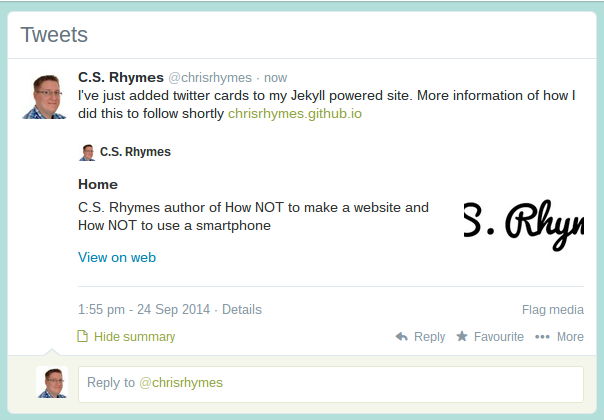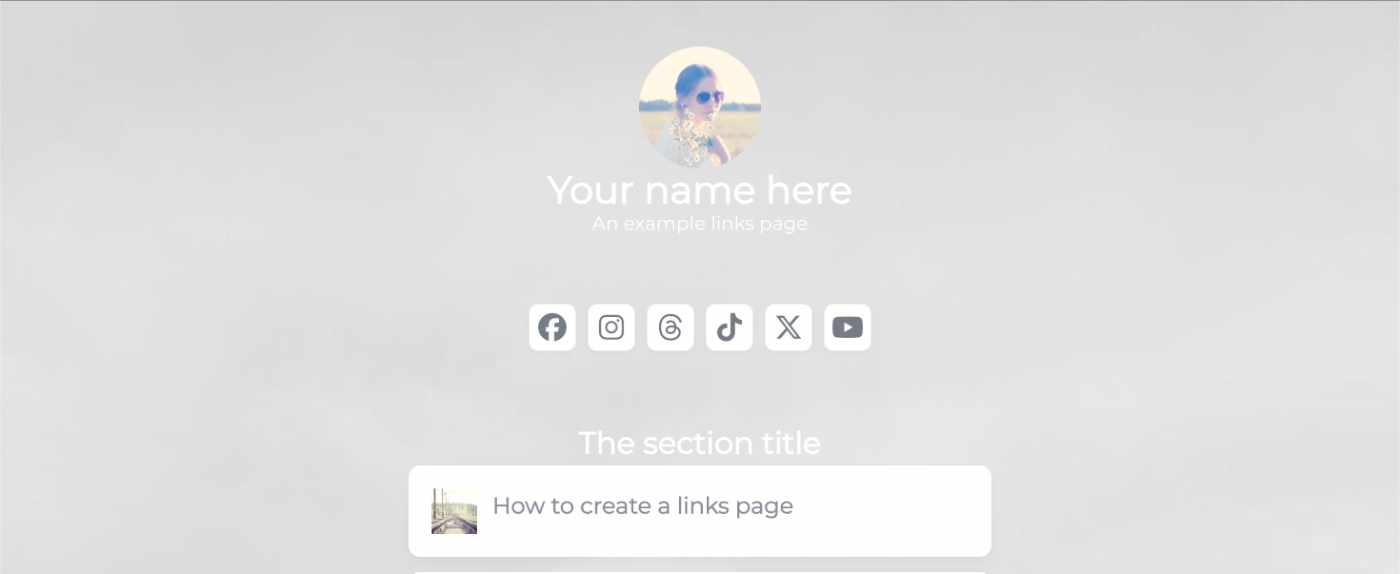We use cookies on this site to enhance your user experience
By clicking the Accept button, you agree to us doing so. More info on our cookie policy
We use cookies on this site to enhance your user experience
By clicking the Accept button, you agree to us doing so. More info on our cookie policy
Published: Sep 24, 2014 by C.S. Rhymes
Twitter cards are a great way of making links to your site stand out to other twitter users. They can be used to provide additional information and an image about your page, from within twitter when you expand a tweet. Examples include twitter summary cards that provide a title, description and image, or product cards that can provide information such as price or product category.

In order to get twitter cards to work, you first need to add twitter meta tags to your pages. In the default Jekyll project the meta tags are held in the head.html file within the includes folder.
There are different types of tags required for different types of twitter cards. For this example I am going to use the default “Summary” card.
For a summary card to work you need the following tags as a minimum:
You can also add an image.
Below is the example HTML meta tags.
<meta name="twitter:card" content="summary" />
<meta name="twitter:site" content="@twitterhandle" />
<meta name="twitter:title" content="Page title goes here" />
<meta name="twitter:description" content="Page description goes in here" />
<meta name="twitter:image" content="Image URL" />
So now you need to add content into the meta tags for each page. To do this I created custom page variables in the front matter of each page and then added the variables to the head.html file. More information about Jekyll page variables can be found in the documentation.
---
title: "Example page title here"
description: "You can use this as the standard description meta tag and twitter description if required"
twitter-description: "This is a specific twitter card description (optional)"
---
I used my standard page title as the content for the twitter:title tag, but I thought I had better put a back up value in there of the site.title in case I forgot to set the title for every page.
{% if page.title %}{{ page.title }}{% else %}{{ site.title }}{% endif %}
The above basically says if there is a page title variable then use that, else (if not) then use the site title variable.
I then created a custom variable for the description. Previously, I have added description for the normal description meta tag (so that each page has a unique description and not using the site description) and then used this variable again within the twitter:description tag. If you want to have a different description for twitter then you can create a new custom variable, for example twitter-description.
<meta name="description" content="{% if page.description %}{{ page.description }}{% else %}{{ site.description }}{% endif %}">
You can then do the same for the image if you require, or you can hard code a single URL for each page (as in the below example) if you don’t have a different image for each page.
<meta name="twitter:card" content="summary" />
<meta name="twitter:site" content="@chrisrhymes" />
<meta name="twitter:title" content="{% if page.title %}{{ page.title }}{% else %}{{ site.title }}{% endif %}" />
<meta name="twitter:description" content="{% if page.description %}{{ page.description }}{% else %}{{ site.description }}{% endif %}" />
<meta name="twitter:image" content="http://chrisrhymes.github.io/img/csrhymeslogo.png" />
Once you have added your twitter card meta tags to your site you then need to go to the twitter devs site and validate your cards. This simply involves copying and pasting your sites URL into the form. It will tell you of any errors it finds for you to fix before it can be validated.
It is normally very quick to get your page validated, but there is also the option to validate your whole site by adding it to the whitelist. The only issue I found with doing this is that you get an email from Twitter for EVERY page in your site telling you the twitter card is ready. This is fine if you have a few pages, but if you have hundreds of pages then you will get hundreds of emails. This seems like a bit of an oversight by twitter.
All sorted? Well, there is one more thing you should know about. Twitter offer an Analytics service that provides some great information, showing you how your tweets convert to impressions and from impressions to clicks. More information is available on the Twitter devs site.
Share
Latest Posts

I’ve seen a few posts recently asking what other authors use for their website. There are many options available, but sometimes you just want a single page with links to your social media profiles and links to your books. This is where Bulma Clean Theme and GitHub pages can come to the rescue.

Building a modern website can sometimes lead you to be so far separated from the end result that is sent to the user. Developers can end up focusing on building sites with component based frontend frameworks, fetching data from APIs and installing hundreds of npm dependencies. We can become more interested in writing great code in their chosen programming language than what we serve to the website visitors. How did we get so far away from writing HTML?

When I launched my cozy mystery series, The Little-Astwick Mysteries, I decided to create a new website to promote it. But I made a few mistakes with SEO that have led to a few issues with Search Engine Optimisation (SEO). Here is how I fixed them.

Unlooked for Tales - a collection of short stories
By C.S. Rhymes
Free on Apple Books and Google Play Books

Nigel's Intranet Adventure
By C.S. Rhymes
From £0.99 or read for free on Kindle Unlimited!